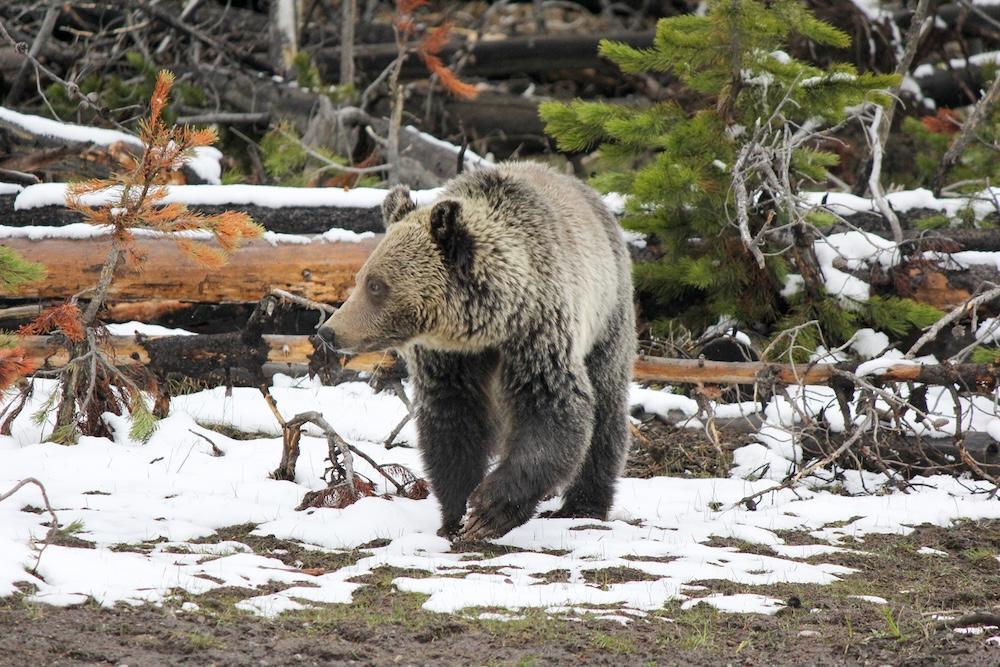
A Yellowstone Grizzly / NPS
Several conservation organizations and grizzly bear proponents have released a vision to bolster support for a unified grizzly bear population within the Northern Rockies. The idea is a holistic framework for recovery, management, and sustainable coexistence between bears and people.
Called “A New Vision for Grizzly Bear Recovery in the Northern Rockies,” the report from nine conservation groups provides a list of actions, policies, and practices to address human conflicts, and offers recommendations for improving and protecting grizzly bear habitat. The report also promotes stewardship and protection of private lands, ways to fix inadequate governance, and adapting grizzly bear recovery efforts to climate change.
The report identifies the following as major threats to grizzly bear survival and recovery: Increases in human conflicts; people account for 85 percent of all grizzly deaths. Declines in essential food sources resulting from climate change and habitat loss. Lack of secure habitat for explorer bears seeking new habitat, dens, mates, and food sources. Sprawling development, which has ballooned in recent years causing loss of open space and habitat connectivity.
Endorsed by 48 organizations and individuals, the vision emphatically supports maintaining grizzly bears’ threatened status under the Endangered Species Act in the lower 48 states, and recognizes that true recovery requires protected habitats that connect isolated populations into a single population to ensure grizzlies can thrive for centuries to come. The new vision aims to fully recover the Northern Rockies population so that it can be a source population of dispersers for aiding recovery in additional suitable habitats.
“This visionary document should transform how we treat grizzly bears and their ecosystems. Today, grizzlies are relegated to vulnerable ecological islands in the Northern Rockies in just 3 to 4 percent of their former range in the lower 48 because of excessive killing and habitat destruction,” said Louisa Wilcox, Co-Founder of Grizzly Times. “The Great Bear has long symbolized renewal and transformation and deserves the respectful approach taken here—and a real shot at flourishing in a rapidly changing world.”
The vision emphasizes the importance of a unified Northern Rockies Recovery Area to help grizzly bears adapt to the predictable impacts of climate change, including shifting food sources and the ever increasing human footprint on the landscape. “At long last we have a blueprint for true grizzly bear recovery and co-existence with people based on the best available scientific information rather than political expediency,” said Mike Bader, an independent consultant in Missoula who studies grizzly bear habitat needs.
The vision calls for managing grizzly bears as one population, including the core populations in recovery zones the government established in 1983, and the suitable habitats on public lands and private lands with conservation easements.
“Grizzly bears were never meant to stay within 'official' government boundaries, and our vision reflects the evolving science showing true recovery requires new thinking and forward-looking management,” said Adam Rissien, ReWilding Manager with WildEarth Guardians. “People broadly support grizzly bear recovery, even if that means changing decad's-old expectations that anti-wildlife lawmakers and bureaucrats still cling to."
“Efforts to recover grizzlies by government agencies in places like the Yaak have been failing spectacularly,” said Rick Bass, director of the Yaak Valley Forest Council. “We need something dramatically different, and this vision document is a fine start.”
One of the vision’s key goals is reestablishing grizzly bears in the Bitterroot Ecosystem, which is vital to recovery in the Northern Rockies. The vision emphasizes the need to reduce conflicts with livestock owners, calling for non-lethal deterrents, and retiring livestock grazing authorizations on public lands. The vision recommends changes in state management practices including prohibiting the hunting of grizzly bears, changes in trapping and snaring regulations, banning the use of baits to attract bears, and the hunting of bears with hounds. It would also require users of grizzly bear habitat to carry bear spray.
"The threats grizzlies face require firm action to protect the lands and the foods they depend on, without which we will surely see their numbers dwindle once again," says Kristin Combs, Executive Director of Wyoming Wildlife Advocates. "Wildlife managers should focus on implementing tools and providing assistance to residents that help people learn how to live alongside the great bear. The future of grizzly bears and our wide open spaces depend on it."

 Support Essential Coverage of Essential Places
Support Essential Coverage of Essential Places






